WOOD LAKE
An aerial view of the lake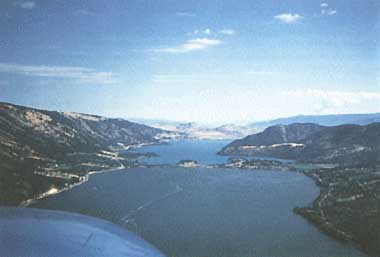
Photo: R.N.Nordin
A. LOCATION
- British Columbia, Canada.
- 50:05N, 119:23W; 391 m above sea level.
B. DESCRIPTION
-
Wood Lake is the first (uppermost) of the chain of five major lakes which occupies portions of the Okanagan Valley in the interior of British Columbia. The Okanagan Valley is a structural trench overlying a system of sub-parallel linked faults that separate the late Paleozoic or early Mesozoic group of metamorphic rocks of differing lithology but of similar age. The trench is partially filled with up to several hundred meters of unconsolidated material. In the Wood Lake area this material is approximately 125 m thick under the centre of Wood Lake. It is likely that the unconsolidated material was deposited in association with earlier glaciations of the Pleistocene Epoch. Glaciation was well advanced by 9750 B. P. and the lakes of the Okanagan Valley were formed by about 8900 B. P.
Wood Lake has a simple "bath tub" shaped basin. This morphometry makes it very suitable for a variety of investigations, particularly the internal physical structure and mass balance study. The natural water residence time is quite long (30 years) and this may be a factor in the generally eutrophic conditions.
The watershed was first settled by Europeans in the last half of the 19th century. The climate (dry warm summers), well drained soils and availability of irrigation water led to the development of a substantial tree fruit industry around the lake and throughout the valley. The upper watershed is heavily forested (predominantly Douglas fir, Pseudotsuga menziesii) and has been logged for several decades. The lower elevation of the watershed is described as a Ponderosa pine (Pinus ponderosa)/bunchgrass community.
Little limnological information was collected prior to 1969 when the Okanagan Basin Study was undertaken. Initiative for this comprehensive program came about primarily due to complaints of poor water quality in Wood Lake and deteriorating water quality in Skaha and Osoyoos Lakes.
Wood Lake has displayed some remarkable changes in the past 20 years. Wood Lake is immediately adjacent to Kalamalka Lake, a larger oligotrophic marl lake, and connected to it by a dredged channel (the Oyama canal). The two lakes have generally demonstrated a dramatic side-by-side contrast in nutrient water chemistry and biological production. Wood Lake was, during the intensive study of the Okanagan Basin Study, described as eutrophic with summer cyanobacterial blooms and large hypolimnetic oxygen depletion. Recent water quality has improved with much better water clarity and other changes. Cooling water taken from Okanagan Lake is used by a distillery in the Wood Lake basin and flows into Wood Lake have reduced the normal water residence time of the lake by half. This change in water residence time as well as other hydrologic and climatic trends may play a role in the water chemistry changes noted in recent years.
During the 1970's, Eurasian milfoil (Myriophyllum spicatum) colonized significant portions of the littoral zone, especially in the shallower southern end of the lake. Combinations of dredging and herbicide treatments have been employed from time to time to limit this nuisance (Q, 2).
C. PHYSICAL DIMENSIONS (1, 2, 3)
| Surface area [km2] | 9 |
| Volume [km3] | 0.1995 |
| Maximum depth [m] | 34 |
| Mean depth [m] | 21.5 |
| Water level*1 | Regulated |
| Normal range of annual water level fluctuation [m] | 1.2 |
| Length of shoreline [km] | 13.5 |
| Residence time [yr] | 16.9*2 |
| Catchment area [km2] | 190 |
*2 1971-1985.
D. PHYSIOGRAPHIC FEATURES
D1 GEOGRAPHICAL- Bathymetric map: Fig. NAM-52-0l.
- Names of main islands: None.
- Number of outflowing rivers and channels (name)
1 (Oyama "canal", short artificial connection to Kalamalka Lake).
- Climatic data at Kelowna Airport, 1940-1970 (4)
| Jan | Feb | Mar | Apr | May | Jun | Jul | Aug | Sep | Oct | Nov | Dec | Ann. | |
|---|---|---|---|---|---|---|---|---|---|---|---|---|---|
| Mean temp. [deg C] | -5.8 | -2.6 | 2.0 | 7.6 | 12.1 | 15.8 | 18.9 | 17.5 | 13.1 | 7.0 | 0.8 | -2.4 | 7.0 |
| Precipitation [mm] | 4 | 8 | 12 | 20 | 23 | 31 | 30 | 22 | 21 | 26 | 26 | 18 | 242 |
- Number of hours of bright sunshine: 1,981.3 hr yr-1 (4a).
- Solar radiation (Summerland Station)[MJ m-2 day-1]
| Jan | Feb | Mar | Apr | May | Jun | Jul | Aug | Sep | Oct | Nov | Dec | Ann. |
|---|---|---|---|---|---|---|---|---|---|---|---|---|
| 3.4 | 6.5 | 11.5 | 16.7 | 20.8 | 22.6 | 23.7 | 19.6 | 14.5 | 8.5 | 3.8 | 2.5 | 12.84 |
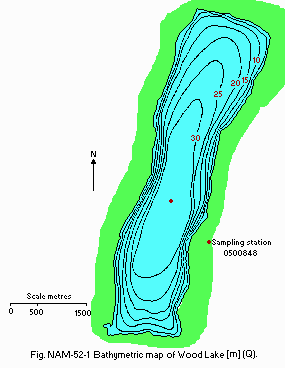
Bathymetric map [m](Q).
- Water temperature [deg C](5)
| Station 0500848, 1987* | ||||||||||||
| Depth [m] | Jan | Feb | Mar | Apr | May | Jun | Jul | Aug | Sep | Oct | Nov | Dec |
|---|---|---|---|---|---|---|---|---|---|---|---|---|
| 0 | - | - | 2.5 | 5.0 | 15.5 | 19.5 | 21.8 | 20.5 | 8.8 | 13.5 | 11.0 | 6.0 |
| 5 | - | - | 2.0 | 4.2 | 13.9 | 18.0 | 21.1 | 19.5 | 18.8 | 13.3 | 10.8 | 6.0 |
| 10 | - | - | 2.0 | 4.0 | 9.2 | 13.0 | 12.8 | 15.8 | 18.6 | 13.5 | 10.8 | 6.0 |
| 15 | - | - | 2.0 | 4.0 | 6.9 | 7.8 | 8.2 | 8.8 | 8.3 | 8.6 | 10.8 | 6.0 |
| 20 | - | - | 2.0 | 4.0 | 6.0 | 6.5 | 6.0 | 6.2 | 6.4 | 6.3 | 6.8 | 6.0 |
| 25 | - | - | 2.0 | 4.0 | 5.6 | 6.0 | 5.6 | 5.5 | 5.7 | 5.9 | 6.0 | 6.0 |
| 30 | - | - | 2.0 | 4.0 | 5.2 | 5.5 | 5.0 | 5.5 | 5.3 | 5.2 | 5.5 | 6.0 |
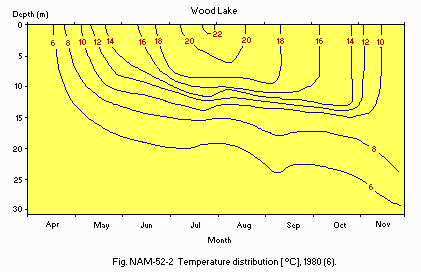
Temperature distribution [deg C], 1980 (6).
- Freezing period: December-February (occasionally).
- Mixing type: Cold monomictic.
- Notes on water mixing and thermocline formation
See (6), (17-20), (34) and (35).
E. LAKE WATER QUALITY (5)
E1 TRANSPARENCY [m]| Station 0500848, 1987 | ||||||||||||
| Depth [m] | Jan | Feb | Mar | Apr | May | Jun | Jul | Aug | Sep | Oct | Nov | Dec |
|---|---|---|---|---|---|---|---|---|---|---|---|---|
| - | - | 6.7 | 4.3 | 5.6 | 8.8 | 3.3 | 3.0 | 4.0 | 7.3 | 10.5 | 6.7 | |
| Station 0500848, 1987* | ||||||||||||
| Depth [m] | Jan | Feb | Mar | Apr | May | Jun | Jul | Aug | Sep | Oct | Nov | Dec |
|---|---|---|---|---|---|---|---|---|---|---|---|---|
| 0 | - | - | 8.2 | 8.4 | 8.7 | 8.4 | 9.3 | 8.7 | 8.6 | 7.8 | - | - |
| 5 | - | - | 7.9 | 8.0 | 8.7 | 8.4 | 9.2 | 8.7 | 8.4 | 7.9 | - | - |
| 10 | - | - | - | - | 8.5 | 8.4 | 8.8 | 8.2 | 8.0 | 7.8 | - | - |
| 20 | - | - | - | - | 8.2 | 8.0 | 7.5 | 7.4 | 7.2 | 7.0 | - | - |
| 25 | - | - | 7.8 | 7.9 | 8.0 | 7.6 | 7.2 | - | 7.1 | 6.9 | - | - |
| 30 | - | - | - | - | 7.9 | 7.2 | 7.1 | 7.4 | 7.0 | 6.9 | - | - |
| Station 0500848, 1987 | ||||||||||||
| Depth [m] | Jan | Feb | Mar | Apr | May | Jun | Jul | Aug | Sep | Oct | Nov | Dec |
|---|---|---|---|---|---|---|---|---|---|---|---|---|
| 0 | - | - | - | - | - | <1 | 3 | 1 | 2 | 1 | 2 | <1 |
| 10 | - | - | - | - | - | <1 | 1 | 1 | 2 | 1 | 1 | 1 |
| 20 | - | - | - | - | - | <1 | 1 | 1 | 2 | 6 | 1 | - |
| 30 | - | - | - | - | - | <1 | - | - | - | - | - | - |
| Station 0500848, 1987 | ||||||||||||
| Depth [m] | Jan | Feb | Mar | Apr | May | Jun | Jul | Aug | Sep | Oct | Nov | Dec |
|---|---|---|---|---|---|---|---|---|---|---|---|---|
| 1 | - | - | 14.4 | 15.8 | 13.2 | 10.5 | 11.1 | 11.0 | 9.8 | 9.6 | 9.0 | 8.2 |
| 5 | - | - | 14.7 | 16.0 | 13.4 | 10.7 | 11.7 | 10.9 | 9.8 | 9.6 | 9.1 | 8.3 |
| 10 | - | - | 14.8 | 15.6 | 13.6 | 10.2 | 9.4 | 5.2 | 9.0 | 9.5 | 9.1 | 8.3 |
| 15 | - | - | 14.8 | 15.2 | 12.5 | 9.4 | 7.7 | 4.0 | 1.1 | 0.8 | 9.1 | 8.2 |
| 20 | - | - | 14.8 | 15.1 | 12.2 | 9.8 | 6.4 | 3.9 | 0.4 | 0.8 | 0.6 | 8.2 |
| 25 | - | - | 14.8 | 15.0 | 11.5 | 9.0 | 4.5 | 1.0 | 0.3 | 0.7 | 0.5 | 8.2 |
| 30 | - | - | 14.8 | 14.8 | 11.1 | 6.3 | 2.3 | 0.6 | 0.2 | 0.6 | 0.4 | 8.2 |
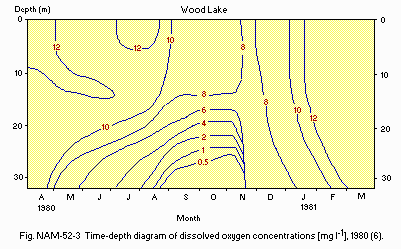
Time-depth diagram of dissolved oxygen concentrations [mg l-1], 1980 (6).
E5 COD [mg l-1]
- Determined by K2Cr2O7 method.
| Station 0500848, 1987 | ||
| Depth [m] | Aug | Sep |
|---|---|---|
| 0 | 17 | 22 |
| 5 | 23 | 22 |
| 10 | 14 | 18 |
| 15 | 13 | 17 |
| 20 | 15 | 17 |
| 25 | 20 | 15 |
| 30 | 18 | 18 |
| Station 0500848, 1987 | ||||||||||||
| Depth [m] | Jan | Feb | Mar | Apr | May | Jun | Jul | Aug | Sep | Oct | Nov | Dec |
|---|---|---|---|---|---|---|---|---|---|---|---|---|
| 0-10* | - | - | 3.9 | 8.4 | 2.8 | 2.4 | 2.6 | 3.3 | 5.6 | 2.0 | 2.9 | 2.4 |
- Total Kjeldahl N + Nitrate N [mg l-1]
| Station 0500848, 1987 | ||||||||||||
| Depth [m] | Jan | Feb | Mar | Apr | May | Jun | Jul | Aug | Sep | Oct | Nov | Dec |
|---|---|---|---|---|---|---|---|---|---|---|---|---|
| *1 | - | - | 0.450 | 0.460 | 0.340 | 0.380 | - | - | - | - | - | - |
| *2 | - | - | 0.490 | 0.440 | 0.430 | 0.560 | 0.590 | - | - | - | - | - |
| 1 | - | - | - | - | - | 0.380 | 0.380 | - | - | - | - | 0.520 |
| 5 | - | - | - | - | - | 0.410 | 0.390 | - | - | - | - | 0.500 |
| 10 | - | - | - | - | - | 0.430 | 0.450 | - | - | - | - | 0.460 |
| 20 | - | - | - | - | - | - | - | - | - | - | - | 0.470 |
| 30 | - | - | - | - | - | - | - | - | - | - | - | 0.570 |
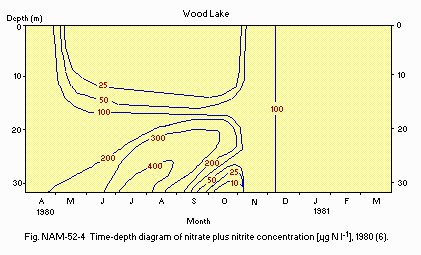
Time-depth diagram of nitrate plus nitrite concentration [ug N l-1], 1980 (6).
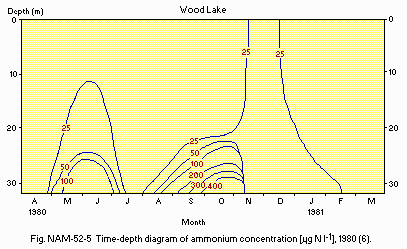
Time-depth diagram of ammonium concentration [ug N l-1], 1980 (6).
E8 PHOSPHORUS CONCENTRATION
- Total-P [micro l-1]
| Station 0500848, 1987 | ||||||||||||
| Depth [m] | Jan | Feb | Mar | Apr | May | Jun | Jul | Aug | Sep | Oct | Nov | Dec |
|---|---|---|---|---|---|---|---|---|---|---|---|---|
| *1 | - | - | 40 | - | - | - | - | - | - | 9 | - | - |
| *2 | - | - | 40 | - | - | - | 86 | - | - | 124 | 133 | - |
| 1 | - | - | - | 37 | 15 | 14 | 16 | 17 | 23 | 11 | 13 | 52 |
| 5 | - | - | 48 | 32 | 19 | 15 | 11 | 24 | 13 | 12 | 53 | - |
| 10 | - | - | 38 | 25 | 23 | 20 | 13 | 19 | 11 | 12 | 55 | - |
| 20 | - | - | 34 | 33 | 28 | - | 40 | 34 | 47 | 48 | 56 | - |
| 30 | - | - | 34 | 54 | 89 | - | 138 | 197 | 235 | 214 | 58 | - |
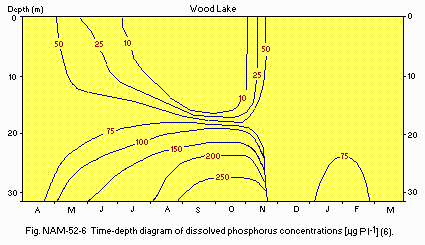
Time-depth diagram of dissolved phosphorus concentrations [ug P l-1](6).
E9 CHLORIDE CONCENTRATION [mg l-1](2)
- Station 0500848, May-October 1982: 3.
F. BIOLOGICAL FEATURES
F1 FLORA- Emerged macrophytes
- Submerged macrophytes
- Phytoplankton (1, 6, 31, 32, 47)
Typha latifolia, Scirpus sp., S. lacustris, Equisetum sp., E. fluviatile, Ranunculus sp., R. aquatilis.
Myriophyllum spicatum (abundant), M. exalbescens, Potamogeton perfoliatus, P. gramineus, P. crispus, P. illinoensis, P. pectinatus, P. nodosus, Chara sp., Elodea canadensis, Ceratophyllum sp., C. demersum.
Aphanizomenon, Anabaena, Lyngbya, Oscillatoria rubescens.
- Zooplankton (1, 23, 58, 60)
Cyclops bicuspidatus thomasi, Diaptomus ashlandi. - Benthos: Very sparse; Chironomus spp. (1, 10, 54).
- Fish: Peamouth chub*, squawfish*, kokanee* (1, 22).
* Important for sport-fishing. - Supplementary notes on the biota
Clemens, et al. (9) reported that in 1935 there was high biomass of benthos. In contrast Saether (10) in 1969 found virtually no benthos present in Wood Lake. No explanation has yet been proposed for this dramatic change.
- Mean annual epilimnetic (0-10 m) chlorophyll a concentration [micro l-1]
| Station 0500245 and 0500848 | |||||
| 1975 | 18.5 | 1979 | 3.1 | 1983 | 3.9 |
| 1976 | 11.9 | 1980 | 3.9* | 1984 | - |
| 1977 | 9.8 | 1981 | 5.7 | 1985 | 5.5 |
| 1978 | 10.8 | 1982 | 2.7 | ||
- Apparent changes in nutrient loading have caused changes in standing crop. May be changes in species composition of phytoplankton (data not analysed), zooplankton (data may not be available) and fisheries (probably no data). Change in benthos standing crop noted in F2. Increases in littoral zone Myriophyllum spicatum population which was introduced from Europe via eastern Canada have been considerable in this and numerous other lakes of British Columbia (2).
G. SOCIO-ECONOMIC CONDITIONS
G1 LAND USE IN THE CATCHMENT AREA (7) (1987)| [km2] | [%] | |
|---|---|---|
| Natural landscape | ||
| - Woody vegetation*1 | 76 | 40 |
| - Swamp | <1 | |
| Agricultural land | ||
| - Crop field*2 | 57 | 30 |
| Residential area | 28.5 | 15 |
| Others*3 | 28.5 | 15 |
| Total | 190 | 100 |
*2 Orchards.
*3 Grassland/pasture.
- Types of important forest vegetation
Douglas fir forest (upper elevations of watershed), Ponderosa pine/open grassland (lower elevations). - Main kinds of crops and/or cropping systems
The watershed directly around the edge of the lake is intensively developed in orchards (mainly apples) which are irrigated from Wood Lake. - Levels of fertilizer application on crop fields: Moderate.
- Trends of change in land use in recent years
Increasing residential development; the Okanagan Valley is a popular retirement area.
| Gross product per year (US$1.00) | No.of persons engaged | Main products pr mSecondary industry |
|---|---|---|
| N.A. | 1 | Distillery |
- Numbers of domestic animals in the catchment area
Small number of horses and cattle.
- Sparsely populated largely agricultural area. Total population of much larger North Okanagan Regional District is 54,352. Town of Winfield (population 3,000) occupies part of the watershed south of Wood Lake.
H. LAKE UTILIZATION
H1 LAKE UTILIZATION (11)- Source of water, sightseeing and tourism (no. of visitors in 1980: total Okanagan receives 6.28 million visitor x days; North Okanagan 25%) and recreation (swimming and sport-fishing).
| Use rate [m3 day-1] | [m3 yr-1] | |
|---|---|---|
| Domestic | ||
| - Waterworks | 341 | |
| - Private intakes 9 | ||
| Irrigation | 363,075 | |
| Industrial | 20 | |
I. DETERIORATION OF LAKE ENVIRONMENTS AND HAZARDS
I1 ENHANCED SILTATION- Extent of damage: Not serious.
- Nuisance caused by eutrophication
Unusual algal bloom (Anabaena flos-aquae, Oscillatoria rubescens, Aphanizomenon flos-aquae; serious problem in early 1970's). - Nitrogen and phosphorus loadings to the lake [t yr-1](11) (1980)
| Sources | Industrial*1 | Domestic*2 | Agricultural*3 | Natural | Total*4 |
|---|---|---|---|---|---|
| T-P | 0.5 | 0.8 | 0.6 | 1.3 | 3.3 |
*2 Septic tanks.
*3 Fertilizer & livestock.
*4 Internal loading may be significant, but is not included.
- Supplementary notes
Concern in early 1970's as a result of heavy cyanobacterial blooms. Since that time water quality has improved, apparently partially as a result of increased flushing rate of the lake (cooling water from a distillery imported from outside the watershed), and possibly due to an increase in the loading N:P ratio (13). Nitrate from the distillery infiltration ponds may be the source of this change. Water quality in recent years remarkably better than early 1970's (3, 6, 11, 13, 16, 64). Water column treatment with alum (15) and sediment treatment with iron (3) considered as means of reducing eutrophication problem.
- Extent of damage: None.
J. WASTEWATER TREATMENTS
J1 GENERATION OF POLLUTANTS IN THE CATCHMENT AREA- (d) Measurable pollution with limited wastewater treatment.
| [%] | |
|---|---|
| Non-point sources* | 100 |
- Percentage of rural population with adequate sanitary facilities (on-site
treatment systems): 100%. - Municipal wastewater treatment systems: None.
K. IMPROVEMENT WORKS IN THE LAKE (3, 13, 15)
K1 RESTORATION- Alum treatment considered; treatment of sediments with iron considered; enhancement of spring diatom sedimentation of phosphorus with nitrate supplements considered.
- Diver operated dredging and 2, 4-D applications to control Eurasian milfoil infestation.
L. DEVELOPMENT PLANS
- Development plans in the lake and catchment area are primarily residential in nature. A continued increasing in housing within the lake's watershed is predicted. No specific large single development has been planned.
M. LEGISLATIVE AND INSTITUTIONAL MEASURES FOR UPGRADING LAKE ENVIRONMENTS
M1 NATIONAL AND LOCAL LAWS CONCERNED- Names of the laws (the year of legislation)
- British Columbia Waste Management Act (1982)
- British Columbia Water Management Act (1979)
- British Columbia Environmental Management Act
- Canada Federal Fisheries Act
- Responsible authorities
- Government of British Columbia, Ministry of Environment
- Government of British Columbia in cooperation with the Government of Canada
- Main items of control
- Control of discharge of waste to land, air, water
- Licensing of water use
- Prevention of activities detrimental to environment
- Management of fisheries
- Supplementary notes
Also indirect regulations of forestry, for example. Also federal legislation such as Environmental Protection Act.
- Okanagan Basin Study (Canada-British Columbia Okanagan Basin Agreement) 1969-1974
- Kalamalka-Wood Lake Basin Water Resource Management Study 1972-1973, Water Investigations Branch, British Columbia Water Resources Service, Victoria
- Okanagan Basin Water Quality Control Project, British Columbia Ministry of Environment, Pentiction, British Columbia, 1986-1989
- National Water Research Institute, Pacific and Yukon Region, West Vancouver
- Hiram Walker Distillery, Winfield, British Columbia, Environmental monitoring 1970-present
- British Columbia Ministry of Environment, Okanagan Sub-regional Office, Penticton, British Columbia
- British Columbia Ministry of Environment, Victoria, British Columbia
- Supplementary notes
The regional office of the Ministry of Environment (Penticton) has collected considerable unpublished water quality data for 1970 to present.
N. SOURCES OF DATA
- Questionnaire filled by Dr. R. N. Nordin, Supervisor, Limnological Studies, British Columbia, Ministry of Environment, Water Management Branch, Victoria, B. C., Canada.
- Pinsent, M. E. & Stockner, J. G. (ed.) (1974) Limnology of the Major Lakes of the Okanagan Basin. Tech. Suppl. 5, Canada-British Columbia Okanagan Basin Agreement.
- Warrington, P. D. (1988) Aquatic Plants, Morphometry and Water and Sediment Chemistry for the Lakes of British Columbia. Unpublished Data Base. British Columbia Ministry of Environment, Victoria.
- Canada; Energy Mines & Resources. 1:50,000 Scale Map 82L/3 (1987). (2a)
- Nordin, R. N. (1987) Wood Lake: Proposal for a Demonstration Project for Water Quality Improvement. 77 pp. Water Management Branch, British Columbia Ministry of Environment and Parks, Victoria.
- Climatic Nosmals, 1941-1970. Climate of British Columbia. British Columbia Department of Agriculture.
- Canadian Climate Normals, 1951-1980. British Columbia. Environment Canada. (4a)
- British Columbia Ministry of Environment. Computer Data Bases EQUIS (1970-85) & SEAM (1985-present).
- Jasper, S. & Gray, C. B. J. (1982) The Chemical and Microbiological Limnology of Wood Lake, British Columbia, 1980. 107 pp. National Water Research Institute, Inland Waters Directorate - Pacific and Yukon Region, West Vancouver.
- Energy, Mines & Resources, N. T. S. 82L/3 Oyama. Ed. 4 (1987).
- Census of Canada (1981) Population Series, British Columbia 93-910. Table 4.
- Clemens, W. A., Rawson, D. S. & McHugh, J. L. (1939) A Biological Survey of Okanagan Lake, British Columbia. Fish. Res. Board Can. Bull. 56. 70 pp.
- Saether, O. A. (1970) A survey of the bottom fauna in lakes of the Okanagan valley, British Columbia. Fish. Res. Board Can. Tech. Report, 196: 1-17.
- Water Management Branch, Waste Management Branch (1985) Phosphorus in the Okanagan Valley Lakes: Sources, Water Quality Objectives and Control Possibilities. 103 pp. British Columbia Ministry of Environment.
- Kalamalka-Wood Lake Basin Water Resource Management Study, 1974. 208 pp. Water Investigations Branch, British Columbia Water Resources Service, Department of Lands, Forests and Water Resources, Victoria.
- Gray, C. B. J. & Jasper, S. (1982) Limnological Trends in Wood Lake, British Columbia (1971 -1981) with Some Implications for Lake Management. 22 pp. Environment Canada, Inland Waters Directorate, Pacific and Yukon Region, West Vancouver, B. C.
- British Columbia Research (1974) Water Quality of the Kalamalka-Wood Lake Basin. 163 pp. Vancouver.
- British Columbia Research (1976) Evaluation of Alum Treatment as a Method to upgrade Wood Lake Water Quality. 32 pp. Vancouver.
- Nordin, S. N. (1980) Strategies for maintaining water quality in two British Columbia lakes. Can. Water Res. J., 5: 90-101.
- Blanton, J. 0. (1972) Relationships between heat content and thermal structure in the mainstem lakes of the Okanagan Valley. 17 pp.
- Blanton, J. 0. & Ng, H. Y. F. (1971) Okanagan Basin studies; data report on the fall survey, 1970. 125 pp.
- Blanton, J. O. & Ng, H. Y. F. (1972) The physical limnology of the mainstem lakes in the Okanagan Basin. 2 volumes, 34 pp., 24 figures, 2 appendices.
- Blanton, J. 0. & Ng, H. Y. F. (1972) The circulation of the effluent from the Okanagan River as it enters Skaha Lake. 23 pp.
- Lerman, A. (1972) Chemical limnology of the major lakes in the Okanagan Basin: nutrient budgets at present and in the future. 41 pp.
- Northcote, T. G. & Halsey, T. G. & MacDonald, S. J. (1972) Fish as indicators of water quality in the Okanagan Basin lakes, British Columbia. 80 pp.
- Patalas, K. & Salki, A. (1973) Crustacean plankton and the eutrophication of lakes in the Okanagan Valley, British Columbia. 34 pp.
- Saether, O. A. & McLean, M. P. (1972) A survey of the bottom fauna in Wood, Kalamalka and Skaha Lakes in the Okanagan Valley, British Columbia. 20 pp.
- St. John, B. E. (1972) The limnogeology of the Okanagan mainstem lakes. 46 pp.
- Stockner, J. G. (1971) Preliminary evaluation; water quality. 4 pp. (1972) Diatom succession in the recent sediments of Skaha Lake, British Columbia. 17 pp. (1972) Nutrient loadings and lake management alternatives. 13 pp.
- Stockner, N. J., Girman, G. D. & Roberts, R. D. (1972) Algal nutrient addition and pure culture bioassay studies on six lakes in the Okanagan Basin, British Columbia. 52 pp.
- Stockner, J. G., Pomeroy, M., Carney, W. & Findlay, D. L. (1972) Studies of periphyton in lakes of the Okanagan Valley, British Columbia. 19 pp.
- Stockner, J. G., Carney, W. & McKenzie, G. (1972) Task 122: phytobenthos, littoral mapping supplement. 10 pp., 16 plates.
- Williams, D. J. (1972) General limnology of the mainstem lakes in the Okanagan Valley, British Columbia. 12 pp.
- Deimert, D. D. & Kelso, B. W. (1980) Algal Analysis of Okanagan Lakes in 1979. Okanagan Basin Implementation Board Progress Report. 14 pp. Penticton.
- Stein, J. R. & Coulthard, T. L. (1971) A Report on the Okanagan Water Investigation 1969-1970. 176 pp. Water Investigations Branch, Department Lands, Forests and Water Resources, Victoria.
- Alexander, D. G. (1982) Summary of Nitrogen and Phosphorus Loadings to the Okanagan Main Valley Lakes from Cultural and Natural Sources. Okanagan Basin Implement Agreement. Working Report. 22 pp. Penticton, B. C.
- Wiegand, R. C. (1984) Data Report on the Physical Limnology of Wood Lake, British Columbia: Observations of Temperature Conductivity, Turbidity and Chl. a, June-October 1981. 21 pp.+ 22 figures + Appendix.
- Wiegand, R. C. & Chamberlin, V. (1987) Internal waves of the second vertical node in a stratified lake. Limnol. Oceanogr., 32: 29-42.
- Bergman, L. A. (1972) Kalamalka-Wood Lake Basin Water Resource Management Study Project Report. BCWRS Report No. 1831.
- Coulson, C. H. (1972) Kalamalka-Wood Lake Basin Study Project 1: Hydrometric Gauging for 1972. BCWRS Report No. 1840.
- Le Breton, E. G. (1971) Kalamalka-Wood Lake Basin Study Project 6: Preliminary Hydrogeological Study. BCWRS Report No. 1844.
- Coulson, C. H. (1972) Kalamalka-Wood Lake Basin Study Project 2: Runoff Conditions in 1969, 1970 and 1971. BCWRS Report No. 1875.
- Bergman, L. A. (1972) Kalamalka-Wood Lake Basin Study: Progress Report to August 1972. BCWRS Report No. 1900.
- Thomas, C. H. (1972) Kalamalka-Wood Lake Basin Study Project 13: Land- use Inventory. BCWRS Report No. 1910.
- Anthony, E. D. (1973) Kalamalka-Wood Lakes, Effect of Discharge from Distillery in Winfield on 1972 Levels. BCWRS Report No. 1935.
- Haley, P. F. (1973) Kalamalka-Wood Lake Basin Study: Analysis of Present and Projected 1980 Angling Activity. BCWRS Report No. 1942.
- Coulson, C. H. (1973) Kalamalka-Wood Lake Basin Study Project 3: Annual Runoff Relationship. BCWRS Report No. 2050.
- Anthony, E. D. (1973) Kalamalka-Wood Lake Basin Study Report on Licensed Water Use in the Kalamalka Lake Watershed. BCWRS Report No. 2081.
- Le Breton, E. G. (1974) A Hydrogeological Study of the Kalamalka-Wood Lake Basin. BCWRS Report No. 2116.
- Buchanan, R. J. & Kirk, N. M. F. (1973) Kalamalka-Wood Lake Basin Study Project 20 (part): Natural Phytoplankton Communities in the Lakes of the Kalamalka-Wood Lake Drainage Basin. BCWRS Report No. 2131.
- Buchanan, R. J. & Soniassy, R. N. (1974) Bioassay Experiments on the Phytoplankton in Water of the Kalamalka-Wood Lake Basin. BCWRS Report No. 2121.
- Thomas, C. H. (1974) Kalamalka-Wood Lake Basin Study Project 14: Economic Basin Study. BCWRS Report No. 2122.
- Haley, P. F. (1974) Water-based Recreation in the Kalamalka-Wood Lake Basin. BCWRS Report No. 2150.
- Halsey, T. G. (1974) Kalamalka-Wood Lake Basin Study Project 22: the Fishery Resources of the Ellison, Wood and Kalamalka Lakes System. British Columbia Fish and Wildlife Branch, Department of Recreation and Conservation.
- 0ldham, W. K. (1974) Task Report on Nutrient Contribution to Transporting Waters in the Vicinity of Source for the Kalamalka-Wood Lake Basin. Department of Civil Engineering, University of British Columbia.
- Howard, T. E. (1974) Water Quality of the Kalamalka-Wood Lake Basin. Division of Applied Biology, B. C. Research.
- Saether, 0. A. & McLean, M. P. (1972) A Survey of the Bottom Fauna in Wood, Kalamalka and Skaha Lakes in the Okanagan Valley, British Columbia. Fish. Res. Board Can. Tech. Report 342. 20 pp.
- Gray, C. B. J. & Jasper, S. (1986) Components of Nutrient Supply and Their Utilization by Phytoplankton in Wood Lake, British Columbia. Unpublished manuscript. National Water Research Institute, West Vancouver, B. C.
- MacDougall, C. (1985) The Chemical and Microbiological Limnology of Wood Lake, British Columbia. Mimeo Report for Hiram Walker Ltd., Winfield, British Columbia. 8 pp.+ data tables.
- Stockner, J. G. & Northcote, T. G. (1974) Recent limnological studies of the Okanagan basin lakes and their contribution to comprehensive water resource planning. J. Fish. Res. Board Can., 31: 955-976.
- Patalas, K. & Salki, A. (1973) Crustacean plankton and the eutrophication of lakes in the Okanagan Valley, British Columbia. J. Fish. Res. Board Can., 30: 519-542.
- Saether, 0. A. (1970) A survey of the bottom fauna in the lakes of the Okanagan Valley, British Columbia. Fish. Res. Board Can. Tech. Report, 196: 1-17.
- Jensen, E. V. (1981) Results of the Continuing Water Quality Monitoring Program on Okanagan Lakes for Years 1979 to 1980. 73 pp. Waste Management Branch, British Columbia Ministry of Environment, Penticton, B. C.
- Northcote, T. G. & Larkin, P. A. (1956) Indices of productivity in British Columbia lakes. J. Fish. Res. Board Can., 13: 515-540.
- Larkin, P. A. & Northcote, T. G. (1958) Factors in lake typology in British Columbia. Verh. Int. Ver. Limnol., 13: 252-263.
- Coulthard, T. L. & Stein, J. R. (1969) A Report on the Okanagan Water Investigation 1968 -1969. Prepared for the Water Investigative Branch, British Columbia Water Resources Service.
- Bryan, J. E. (1988) Summary of Water Quality Trends in Lakes of the Okanagan Region to Spring 1988. Memo. Report to R. A. Nickel, 3 0ct. 1988, File 50.6000. 9 pp. British Columbia Ministry of Environment, Waste Management Branch, Penticton, B. C.
References (17)-(30) are the technical reports prepared during the Okanagan Basin study.


